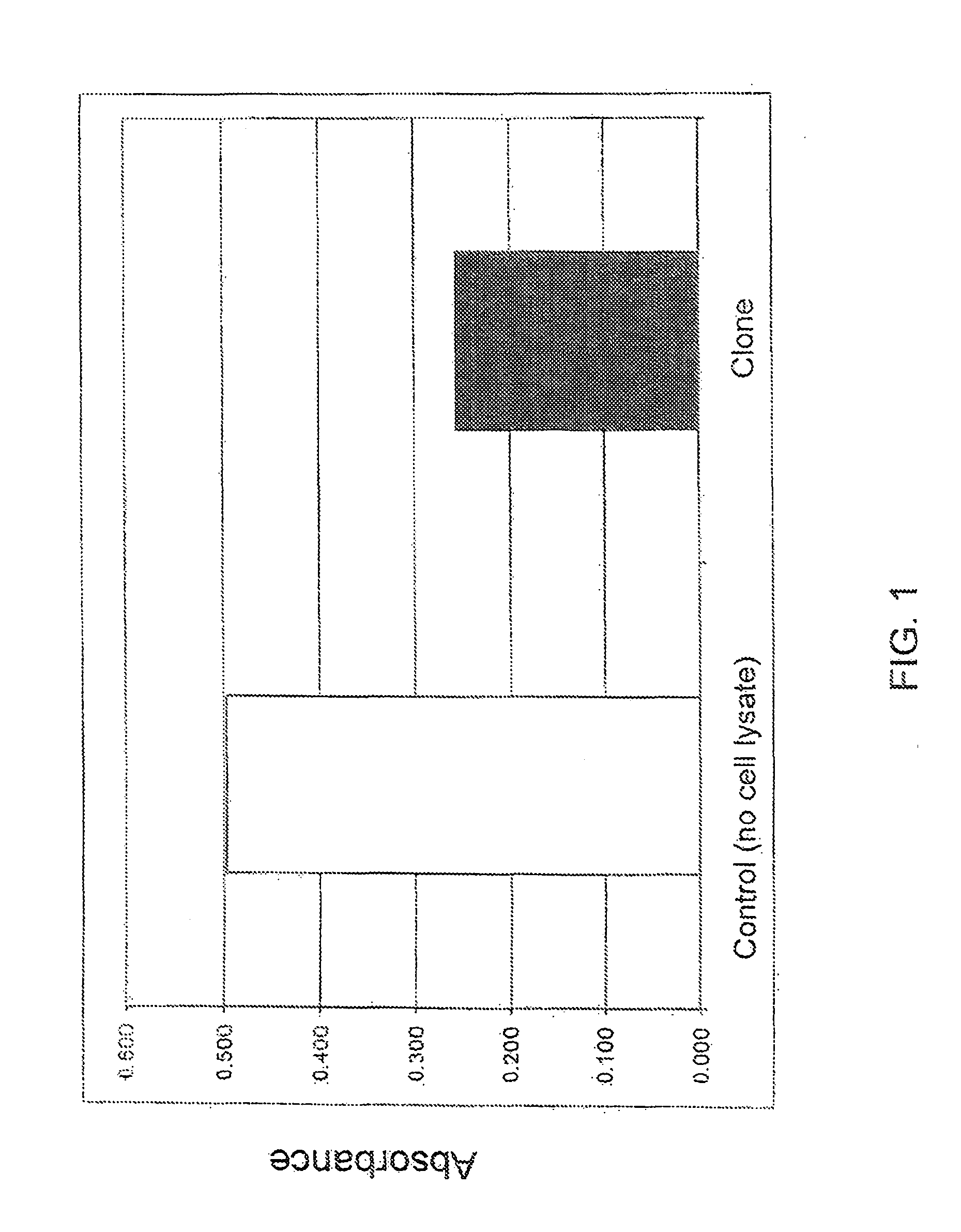Cell lines expressing guanylate cyclase-c and methods of using them
a technology of guanyl cyclase and cell lines, applied in the field of guanyl cyclasec, can solve the problems of hampered discovery of new and improved therapeutics that specifically target gc-c and other guanyl cyclase family members, and achieve the effect of accurate assay readou
- Summary
- Abstract
- Description
- Claims
- Application Information
AI Technical Summary
Benefits of technology
Problems solved by technology
Method used
Image
Examples
example 1
Generating a Stable GC-C-Expressing Cell Line
[0098]293T cells were transfected with a plasmid encoding the human GC-C gene (SEQ ID NO: 2) using standard techniques. (Examples of reagents that may be used to introduce nucleic acids into host cells include, but are not limited to, LIPOFECTAMINE™, LIPOFECTAMINE™ 2000, OLIGOFECTAMINE™, TFX™ reagents, FUGENE® 6, DOTAP / DOPE, Metafectine or FECTURIN™.)
[0099]Although drug selection is optional in the methods of this invention, we included one drug resistance marker in the plasmid encoding the human GC-C gene. The GC-C sequence was under the control of the CMV promoter. An untranslated sequence encoding a tag for detection by a signaling probe was also present along with a sequence encoding a drug resistance marker. The target sequence utilized was Target Sequence 1 (SEQ ID NO: 1). In this example, the GC-C gene-containing vector contained Target Sequence 1.
[0100]Transfected cells were grown for 2 days in Dulbecco's Modified Eagles medium (D...
example 2
Characterizing the Cell Lines for Native GC-C Function
[0123]A competitive ELISA for detection of cGMP was used to characterize native GC-C function in the produced GC-C-expressing cell line. Cells expressing GC-C were maintained under standard cell culture conditions in DMEM supplemented with 10% fetal bovine serum, glutamine and HEPES and grown in T175 cm flasks. For the ELISA, the cells were plated into coated 96-well plates (poly-D-lysine).
Cell Treatment and Cell Lysis Protocol
[0124]Cells were washed twice with serum-free medium and incubated with 1 mM IBMX for 30 minutes. Desired activators (i.e., guanylin, 0.001-40 μM) were then added to the cells and incubated for 30-40 minutes. Supernatant was removed, and the cells were washed with TBS buffer. The cells were lysed with 0.1 N HCl. This was followed by lysis with 0.1N HCl and a freeze / thaw cycle at −20° C. / room temperature. Defrosted lysates (samples were spun in Eppendorf tubes at 10,000 rpm) were centrifuged to pellet cell d...
example 3
Generation of GC-C-Expressing Cell Line Z′ Value
[0129]Z′ for the produced GC-C-expressing cell line was calculated using a direct competitive ELISA assay. The ELISA was performed using the Direct Cyclic GMP Enzyme Immunoassay Kit (Cat. 900-014; AssayDesigns, Inc.). Specifically, for the Z′ assay, 24 positive control wells in a 96-well assay plate (plated at a density of 160,000 or 200,000 cells / well) were challenged with a GC-C activating cocktail of 40 μM guanylin and IBMX in DMEM media for 30 minutes. Considering the volume and surface area of the 96-well assay plate, this amount of guanylin created a concentration comparable to the 10 μM used by Forte et al. (1999) Endocr. 140(4), 1800-1806. An equal number of wells containing clonal cells in DMEM / IMBX were challenged with vehicle alone (in the absence of activator). Absorbance (corresponding to cGMP levels) in the two conditions was monitored using a SAFIRE2™ plate reader (Tecan). Mean and standard deviations in the two conditio...
PUM
| Property | Measurement | Unit |
|---|---|---|
| Time | aaaaa | aaaaa |
| Time | aaaaa | aaaaa |
| Time | aaaaa | aaaaa |
Abstract
Description
Claims
Application Information
 Login to View More
Login to View More - R&D
- Intellectual Property
- Life Sciences
- Materials
- Tech Scout
- Unparalleled Data Quality
- Higher Quality Content
- 60% Fewer Hallucinations
Browse by: Latest US Patents, China's latest patents, Technical Efficacy Thesaurus, Application Domain, Technology Topic, Popular Technical Reports.
© 2025 PatSnap. All rights reserved.Legal|Privacy policy|Modern Slavery Act Transparency Statement|Sitemap|About US| Contact US: help@patsnap.com


